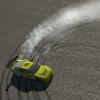Hello,
I've ran into some problems when trying to do locked differentials. I quite dont understand how to use preload torque on velocity difference based differentials. So what I know, is that:
- a open differential has equal torques and unequal velocityes (lighter wheel spins more).
- a locked differential has equal velocityes and unequal torques (lighter wheel has less torque).
So what I dont know is: a preload torque, does it mean that the differential stays locked until some point and after that point the differential becomes unlocked (so its action is quite reversal to an lsd differential right?) now after the differential becomes unlocked the lsd part comes to play and try to match up the speeds?
...this all seems a bit jibberish to me and un logical. Since a lsd differential has angled wedges in them wich allow the differential to lock up. The simplest way I could do a close to a locked differential is velocity difference method. Like this:
velocityDifference = (leftSpeed-rightSpeed)
leftTorque = driveTorque - (velocityDifference * 2000)
rightTorque = driveTorque + (velocityDifference * 2000)2000 is a magic constant. Currently this constant gives enough torque to lock up the diff almost 100% (some small velocity difference still exists) So my question is,
Is my constant "2000" the preload torque? If so where comes the lsd part in??? Another question would be, where to use road reaction torques? From racer's doc's(http://www.racer.nl/tutorial/differentials.htm) I read that I should use the feedbackTorque from both sides to define if the differential is locking or not, but the preload part doesn't make sense to me.







